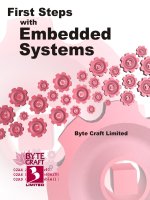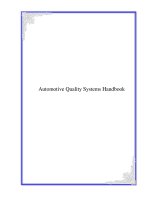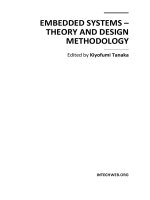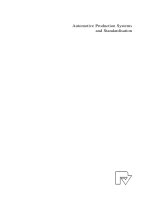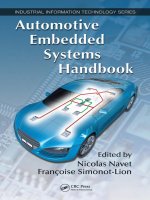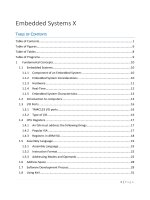automotive embedded systems
Bạn đang xem bản rút gọn của tài liệu. Xem và tải ngay bản đầy đủ của tài liệu tại đây (7.58 MB, 490 trang )
Navet/Automotive Embedded Systems Handbook _C Finals Page i -- #
Automotive
Embedded
Systems
Handbook
Navet/Automotive Embedded Systems Handbook _C Finals Page ii -- #
Automotive Embedded Systems Handbook
Edited by Nicolas Navet and Françoise Simonot-Lion
Integration Technologies for Industrial Automated Systems
Edited by Richard Zurawski
Electronic Design Automation for Integrated Circuits Handbook
Edited by
Luciano Lavagno, Grant Martin, and Lou Scheffer
Embedded Systems Handbook
Edited by Richard Zurawski
Industrial Communication Technology Handbook
Edited by Richard Zurawski
Series Editor
RICHARD ZURAWSKI
INDUSTRIAL INFORMATION TECHNOLOGY SERIES
Navet/Automotive Embedded Systems Handbook _C Finals Page iii -- #
Automotive
Embedded
Systems
Handbook
INDUSTRIAL INFORMATION TECHNOLOGY SERIES
CRC Press is an imprint of the
Taylor & Francis Group, an informa business
Boca Raton London New York
Navet/Automotive Embedded Systems Handbook _C Finals Page iv -- #
CRC Press
Taylor & Francis Group
6000 Broken Sound Parkway NW, Suite 300
Boca Raton, FL 33487-2742
© 2009 by Taylor & Francis Group, LLC
CRC Press is an imprint of Taylor & Francis Group, an Informa business
No claim to original U.S. Government works
Printed in the United States of America on acid-free paper
10 9 8 7 6 5 4 3 2 1
International Standard Book Number-13: 978-0-8493-8026-6 (Hardcover)
This book contains information obtained from authentic and highly regarded sources. Reasonable
efforts have been made to publish reliable data and information, but the author and publisher can-
not assume responsibility for the validity of all materials or the consequences of their use. The
authors and publishers have attempted to trace the copyright holders of all material reproduced
in this publication and apologize to copyright holders if permission to publish in this form has not
been obtained. If any copyright material has not been acknowledged please write and let us know so
we may rectify in any future reprint.
Except as permitted under U.S. Copyright Law, no part of this book may be reprinted, reproduced,
transmitted, or utilized in any form by any electronic, mechanical, or other means, now known or
hereafter invented, including photocopying, microfilming, and recording, or in any information
storage or retrieval system, without written permission from the publishers.
For permission to photocopy or use material electronically from this work, please access www.copy-
right.com ( or contact the Copyright Clearance Center, Inc. (CCC), 222
Rosewood Drive, Danvers, MA 01923, 978-750-8400. CCC is a not-for-profit organization that pro-
vides licenses and registration for a variety of users. For organizations that have been granted a
photocopy license by the CCC, a separate system of payment has been arranged.
Trademark Notice: Product or corporate names may be trademarks or registered trademarks, and
are used only for identification and explanation without intent to infringe.
Library of Congress Cataloging-in-Publication Data
Automotive embedded systems handbook / edited by Nicolas Navet and
Francoise Simonot-Lion.
p. cm. (Industrial information technology ; 5)
Includes bibliographical references and index.
ISBN-13: 978-0-8493-8026-6
ISBN-10: 0-8493-8026-X
1. Automotive computers. 2. Automobiles Electronic equipment. 3.
Automobiles Automatic control Equipment and supplies. 4. Embedded
computer systems. I. Navet, Nicolas. II. Simonot-Lion, Francoise. III. Title. IV.
Series.
TL272.53.A9868 2009
629.2 dc22 2008024406
Visit the Taylor & Francis Web site at
and the CRC Press Web site at
Navet/Automotive Embedded Systems Handbook _C Finals Page v -- #
Contents
Preface vii
Editors xv
Contributors xvii
Part I Automotive Architectures
Vehicle Functional Domains and eir Requirements Françoise
Simonot-Lion and Yvon Trinquet
-
Application of the AUTOSAR Standard Stefan Voget, Michael
Golm, Bernard Sanchez, and Friedhelm Stappert
-
Intelligent Vehicle Technologies Michel Parent and Patrice Bodu -
Part II Embedded Communications
A Review of Embedded Automotive Protocols Nicolas Navet
and Françoise Simonot-Lion
-
FlexRay Protocol Bernhard Schätz, Christian Kühnel, and
Michael Gonschorek
-
Dependable Automotive CAN Networks Juan Pimentel,
Julian Proenza, Luis Almeida, Guillermo Rodriguez-Navas,
Manuel Barranco, and Joaquim Ferreira
-
Part III Embedded Software and Development
Processes
Product Lines in Automotive Electronics Matthias Weber
and Mark-Oliver Reiser
-
Reuse of Soware in Automotive Electronics Andreas Krüger,
Bernd Hardung, and orsten Kölzow
-
v
Navet/Automotive Embedded Systems Handbook _C Finals Page vi -- #
vi Contents
Automotive Architecture Description Languages Henrik Lönn
and Ulrich Freund
-
Model-Based Development of Automotive Embedded Systems
Martin Törngren, DeJiu Chen, Diana Malvius
and Jakob Axelsson
-
Part IV Verification, Testing, and Timing
Analysis
Testing Automotive Control Soware Mirko Conrad and Ines Fey -
Testing and Monitoring of FlexRay-Based Applications Roman
Pallierer and omas M. Galla
-
Timing Analysis of CAN-Based Automotive Communication
Systems omas Nolte, Hans A. Hansson, Mikael Nolin,
and Sasikumar Punnekkat
-
Scheduling Messages with Osets on Controller Area Network:
A Major Performance Boost Mathieu Grenier, Lionel Havet,
and Nicolas Navet
-
Formal Methods in the Automotive Domain: e Case of TTA
Holger Pfeifer
-
Index I-
Navet/Automotive Embedded Systems Handbook _C Finals Page vii -- #
Preface
e objective of the Automotive Embedded Systems Handbook is to provide a com-
prehensive overview about existing and future automotive electronic systems. e
distinctive features of the automotive world in terms of requirements, technolo-
gies, and business models are highlighted and state-of-the-art methodological and
technical solutions are presented in the following areas:
• In-vehicle architectures
• Multipartner development processes (subsystem integration, product line
management, etc.)
• Soware engineering methods
• Embedded communications
• Safety and dependability assessment: validation, verication, and testing
e book is aimed primarily at automotive engineering professionals, as it can serve
as a reference for technical matters outside their eld of expertise and at practicing
or studying engineers, in general. On the other hand, it also targets research scien-
tists, PhD students, and MSc students from the academia as it provides them with a
comprehensive introduction to the eld and to the main scientic challenges in this
domain.
Over the last years, there has been an exponential increase in the number
of computer-based functions embedded in vehicles. Development processes, tech-
niques, and tools have changed to accommodate that evolution. A whole range of
electronic functions, such as navigation, adaptive control, trac information, traction
control, stabilization control, and active safety systems, are implemented in today’s
vehicles. Many of these new functions are not stand-alone in the sense that they
need to exchange information—and sometimes with stringent time constraints—with
other functions. For example, the vehicle speed estimated by the engine controller
or by wheel rotation sensors needs to be known in order to adapt the steering
eort, to control the suspension, or simply to choose the right wiper speed. e
complexity of the embedded architecture is continually increasing. Today, up to
signals (i.e., elementary information such as the speed of the vehicle) are
exchanged through up to electronic control units (ECUs) on ve dierent types
of networks.
One of the main challenges of the automotive industry is to come up with methods
and tools to facilitate the integration of dierent electronic subsystems coming from
various suppliers into the vehicle’s global electronic architecture. In the last years,
vii
Navet/Automotive Embedded Systems Handbook _C Finals Page viii -- #
viii Preface
several industry-wide projects have been undertaken in that direction (AEE
∗
,EAST,
AUTOSAR, OSEK/VDX, etc.) and signicant results have already been achieved (e.g.,
standard components such as operating systems, networks and middleware, “good
practices,” etc.). e next step is to build an accepted open soware architecture, as
well as the associated development processes and tools, which should allow for easily
integrating the dierent functions and ECUs provided by carmakers and third-part
suppliers. is is ongoing work in the context of the AUTOSAR project.
As all the functions embedded in cars do not have the same performance or safety
needs, dierent qualities of service are expected from the dierent subsystems. Typ-
ically, an in-car embedded system is divided into several functional domains that
correspond to dierent features and constraints. Two of them are concerned specif-
ically with real-time control and safety in the vehicle’s behavior: the “power train”
(i.e., control of engine and transmission) and the “chassis” (i.e., control of suspension,
steering, and braking) domains. For these safety-critical domains, the technical solu-
tions must ensure that the system is dependable (i.e., able to deliver a service that can
be justiably trusted) while being cost-eective at the same time.
ese technical problems are very challenging, in particular due to the introduction
of X-by-wire functions, which replace the mechanical or hydraulic systems, such
as braking or steering, with electronic systems. Design paradigms (time-triggered,
“safety by construction”), communication networks (FlexRay, TTP/C), and middle-
ware layers (AUTOSAR COM) are currently being actively developed in order to
address these needs for dependability.
e principal players in the automotive industry can be divided into:
• Vehicle manufacturers
• Automotive third-part suppliers
• Tool and embedded soware suppliers
e relationships between them are very complex. For instance, suppliers provid-
ing key technologies are sometimes in a very strong position and may impose their
technical approach on carmakers. Since the competition is erce among carmak-
ers and suppliers, keeping the company’s know-how condential is crucial. is has
strong implications in the technical eld. For instance, the validation of the system
(i.e., verifying that the system meets its constraints) may have to be carried out
∗
Architecture Electronique Embarquée (AEE, –) is a French project supported by the Ministry
of Industry with PSA and Renault, Sagem, Siemens, and Valeo as main industrial partners. Its main
objective was to nd solutions for easing the portability of applicative level soware. Embedded
Electronic Architecture (EAST-EEA, –, see is an European ITEA
project involving most major European carmakers, automotive third-part suppliers, tools and
middleware suppliers, and research institutes. Automotive Open Architecture (AUTOSAR, –
, see ) is an ongoing follow-up to EAST-EAA aimed at establishing open
standards for automotive embedded architecture. Open systems and the corresponding interfaces
for automotive electronics (OSEK, see ) is a German automotive industry
project dening standards for soware components used for communication, network management,
and operating systems. Some of the outcomes of OSEK (e.g., OSEK/OS) are already widely used in
production cars.
Navet/Automotive Embedded Systems Handbook _C Finals Page ix -- #
Preface ix
with techniques that do not require full knowledge of the design rationales and
implementation details.
Shorteningthetimetomarketputsonaddedpressurebecausecarmakersmustbe
able to propose their innovations—that usually rely heavily on electronic systems—
within a time frame that allows for these innovations to be really considered as
innovative. e players involved strive to reduce the development time while the sys-
tem’s overall complexity increases, demanding even more time. is explains why,
despite the economic competition, they have agreed to work together to dene stan-
dard components and reference architecture that will help cut overall development
time.
is book contains contributions, written by leading experts from industry
and academia directly involved in the engineering and research activities treated in
this book. Many of the contributions are from industry or industrial research estab-
lishments at the forefront of the automotive domain: Siemens (Germany), ETAS
(Germany), Volvo (Sweden), Elektrobit (Finland), Carmeq (Germany), e Math-
Works Inc. (United States), and Audi (Germany). e contributions from academia
and research organizations are presented by renowned institutions such as Technical
University of Berlin (Germany), LORIA-Nancy University (France), INRIA (France),
IRCCyN Nantes University (France), KTH (Sweden), Mälardalen University (Swe-
den), Kettering University (United States), University of Aveiro (Portugal), and Ulm
University (Germany).
Organization
Automotive Architectures
is part provides a broad introduction to automotive embedded systems, their
design constraints, and AUTOSAR as the emerging de facto standard. Chapter ,
“Vehicle Functional Domains and eir Requirements,” introduces the main func-
tions embedded in a car and how these functions are divided into functional domains
(chassis, power train, body, multimedia, safety, and human–machine interfaces).
Some introductory words describe the specicities of the development process as well
as the requirements in terms of safety, comfort, performance, and cost that need to be
taken into account.
In Chapter , “Application of the AUTOSAR Standard,” the authors tackle the
problem of the standardization of in-vehicle embedded electronic architectures. ey
analyze the current status of soware in the automotive industry and present the spec-
ications elaborated within the AUTOSAR consortium in terms of standardization.
Particular attention has to be paid to AUTOSAR because it is becoming a standard
that everyone has to understand and deal with.
Finally, Chapter , “Intelligent Vehicle Technologies,” presents the key technologies
that have been developed to meet today’s, and tomorrow’s, automotive challenges in
terms of safety, better use of energy, and better use of space, especially in cities. ese
technologies, such as sophisticated sensors (radar, stereo-vision, etc.), wireless net-
works, or intelligent driving assistance, will facilitate the conception of partially or
Navet/Automotive Embedded Systems Handbook _C Finals Page x -- #
x Preface
fully autonomous vehicles that will reshape the transport landscape and commuters’
travel experience in the twenty-rst century.
Embedded Communications
e increasing complexity of electronic architectures embedded in a vehicle, and
locality constraints for sensors and actuators, has led the automotive industry to
adopt a distributed approach for implementing the set of functions. In this context,
networks and protocols are of primary importance. ey are the key support for
integrating functions, reducing the cost and complexity of wiring, and furnishing
a means for fault tolerance. eir impact in terms of performance and dependabil-
ity is crucial as a large amount of data is made available to the embedded functions
through the networks. is part includes three chapters dedicated to networks and
protocols.
Chapter , “A Review of Embedded Automotive Protocols,” outlines the main pro-
tocols used in automotive systems; it presents the features and functioning schemes
of CAN, J, FlexRay, TTCAN, and the basic concepts of sensor/actuator networks
(LIN, TTP/A) and multimedia networks (MOST, IDB). e identication of the
communication-related services commonly oered by a middleware layer and an
overview of the AUTOSAR proposals conclude the chapter.
CAN is at present the network that is the most widely implemented in vehicles.
Nevertheless, despite its eciency and performance, CAN does not possess all the
features that are required for safety-critical applications. e purpose of the chap-
ter, “Dependable Automotive CANs,” is to point out CAN’s limitations, which reduce
dependability, and to present technical solutions to overcome or minimize these lim-
itations. In particular, the authors describe techniques, protocols, and architectures
based on CAN that improve the dependability of the original protocol in some aspects
while still maintaining a high level of exibility, namely (Re)CANcentrate, CANELy,
FTT-CAN, and FlexCAN.
With the development of technology, there has been an increasing number of func-
tions with strong needs in terms of data bandwidth. In addition, safety requirements
have become more and more stringent. To answer to both of these constraints, in
, the automotive industry began to develop a new protocol—FlexRay. Chapter
“FlexRay Protocol,” explains the rationale of FlexRay and gives a comprehensive
overview of its features and functioning scheme. Finally, an evaluation of the impact
of FlexRay on the development process concludes the chapter.
Embedded Software and Development Processes
e design process of an electronic-embedded system relies on a tight cooperation
between car manufacturers and suppliers under a specic concurrent engineering
approach. Typically, carmakers provide the specication of the subsystems to suppli-
ers, who are then inchargeof the design and realization of these subsystems, including
the soware and hardware components, and possibly the mechanical or hydraulic
parts. e results are furnished to the carmakers, who in turn integrate them into
the car and test them. en comes the “calibration” phase, which consists of tuning
Navet/Automotive Embedded Systems Handbook _C Finals Page xi -- #
Preface xi
control and regulation parameters in order to meet the required performances of the
controlled systems. Any error detected during the integration phase leads to costly
corrections in the specication or design steps. For this reason, in order to improve
the eectiveness of the development process, new design methodologies are emerg-
ing, in particular, the concept of a virtual platform, which is now gaining acceptance
in the area of the electronic automotive systems design.
e virtual platform concept requires modeling techniques that are suited to the
design and validation activities at each step of the development process. In this con-
text, model-based development (MBD) has been extensively studied by both car
manufacturers and suppliers. How to adapt this approach to the automotive indus-
try is discussed in Chapter , “Model-Based Development of Automotive Embedded
Systems.” is chapter identies the benets of model-based development, explores
the state of practice, and looks into the major challenges for the automotive industry.
One of the main issues in automotive systems is to reduce the time to market. e
reuse of components, or of subsystems, is one way to achieve this objective. In Chap-
ter , “Reuse of Soware in Automotive Electronics,” the authors give an overview of
the challenges faced when reusing soware in the automotive industry, the dierent
viewpoints on the reuse issue of manufacturers and suppliers, and the impact of the
multipartner development approach.
Sharing the same modeling language between the dierent parties involved in
development is an eective means to ease the cooperative development process. e
main purpose of such a language is, on the one hand, to support the description of
the system at the dierent steps of its development (requirement specication, func-
tional specication, design, implementation, tuning, etc.) according to the dierent
points of view and, on the other hand, to ensure a consistency between these dierent
views. Another important aspect is its ability to reect the structure of the embed-
ded systems as an architecture of components (hardware components, functional
components, soware components). e ideas and principles brought by architec-
ture description languages (ADLs) are well suited to these objectives. What is an
ADL? Why are ADLs needed? What are the main existing ADLs and their associ-
ated tools? What are the main ongoing projects in the automotive context? Answers
to these questions can be found in Chapter “Automotive Architecture Description
Languages.”
e introduction and management of product lines is of primary importance for
the automotive industry. ese product lines are linked to mechanical system vari-
ations, and certain customer-visible variations, oered in a new car. e purpose
of Chapter , “Product Lines in Automotive Electronics” is to present the system-
atic planning and continuous management of variability throughout the development
process. is chapter provides sometechniques on how to model the variability as well
as traceability guidelines for the dierent phases of development.
Verification, Testing, and Timing Analysis
Some functions in a car are critical from the safety point of view, such as, for exam-
ple, certain functions in the chassis or the power train domain. us, validation and
verication are of primary importance.
Navet/Automotive Embedded Systems Handbook _C Finals Page xii -- #
xii Preface
Testing is probably the most commonly used verication technique in the automo-
tive industry. A general view on testing approaches is given in Chapter “Testing
Automotive Control Soware.” In particular, this chapter describes current prac-
tices and several methods that are involved in the testing activities, such as the
classication-tree method, test scenario selection approaches, and black-box/white-
box testing processes. As already mentioned, communication networks and protocols
are key factors for the dependability and performance of an embedded system. Hence,
certain properties on communication architectures have to be veried. Chapter ,
“Testing and Monitoring of FlexRay-Based Applications,” deals with the application
of testing techniques to the FlexRay protocol. e authors review the constraints in
the validation step in the development process of automotive applications and explain
how fault-injection and monitoring techniques can be used for testing FlexRay.
As CAN is the most popular network embedded in cars, its evaluation has been
the subject of a long line of research. Chapter , “Timing Analysis of CAN-Based
Automotive Communication Systems,” summarizes the main results that have been
obtained over the last years in the eld of timing analysis on CAN. In particular,
it is explained how to calculate bounds on the delays that frames experience before
arriving at the receiver end (i.e., the response times of the frames). Accounting for the
occurrence of transmission errors, for instance due to electromagnetic interferences,
is also covered in this chapter. Due to its medium access control protocol based on
the priorities of the frames, CAN possesses good real-time characteristics. However,
a shortcoming that becomes increasingly problematic is its limited bandwidth. One
solution that is being investigated by car manufacturers is to schedule the messages
with osets, which leads to a desynchronization of the message streams. As shown in
Chapter , “Scheduling Messages with Osets on Controller Area Network: A Major
Performance Boost,” this “trac shaping” strategy is very benecial in terms of worst-
case response times. e experimental results suggest that sound oset strategies may
extend the life span of CAN further, and may defer the introduction of FlexRay and
additional CANs.
Chapter “Formal Methods in the Automotive Domain: e Case of TTA,”
describes the formal verication research done in the context of time-triggered archi-
tecture (TTA), and more specically the work that concerns time-triggered protocol
(TTP/C), which is the core underlying communication network of the TTA. ese
formal verication eorts have focused on crucial algorithms in distributed systems:
clock synchronization, group membership algorithm, or the startup algorithm, and
have led to strong results in terms of dependability guarantees. To the best of our
knowledge, TTA is no longer being considered or implemented in cars. Neverthe-
less, the experience gained over the years with the formal validation of the TTA will
certainly prove to be extremely valuable for other automotive communication proto-
cols such as FlexRay, especially in the perspective that certication procedures will be
enforced for automotive systems, as they are now for avionic systems.
We would like to express our gratitude to all of the authors for the time and energy
they have devoted to presenting their topic. We are also very grateful to Dr. Richard
Zurawski, editor of the Industrial Information Technology Series, for his continuous
support and encouragements. Finally, we would like to thank CRC Press for having
agreed to publish this book and for their assistance during the editorial process.
Navet/Automotive Embedded Systems Handbook _C Finals Page xiii -- #
Preface xiii
We hope that you, the readers of this book, will nd it an interesting source of
inspiration for your own research or applications, and that it will serve as a reliable,
complete, and well-documented source of information for automotive-embedded
systems.
Nicolas Navet
Françoise Simonot-Lion
Navet/Automotive Embedded Systems Handbook _C Finals Page xiv -- #
Navet/Automotive Embedded Systems Handbook _C Finals Page xv -- #
Editors
Nicolas Navet has been a researcher at the Grand Est Research Centre at the National
Institute for Research in Computer Science and Control (INRIA), Nancy, France,
since . His research interests include real-time scheduling, the design of com-
munication protocols for real-time and fault-tolerant data transmission, and depend-
ability evaluation when transient faults may occur (e.g., EMI). He has authored more
than refereed publications and has received the CAN in Automation International
Users and Manufacturers Group research award in as well as ve other distinc-
tions (e.g., best paper awards). Since , he has worked on numerous contracts and
projects with automotive manufacturers and suppliers. He is the founder and chief
scientic ocer of RealTime-at-Work, a company dedicated to providing services
and soware tools that help optimize the hardware resource utilization and verify
that dependability constraints are met. He holds a BS in computer science from the
University of Berlin, Berlin, Germanyand a PhD in computer science from the Institut
National Polytechnique de Lorraine, Nancy, France.
Françoise Simonot-Lion is a professor of computer science at University of Nancy,
Nancy,France. She hasbeenthescientic leader of the Real Time and InterOperability
(TRIO) research team since , which is an INRIA project at the Lorraine Labo-
ratory of Computer Science Research and Applications (LORIA) in Nancy, France.
From to , she was responsible for CARAMELS, a joint research team with
PSA Peugeot Citroën funded by the French Ministry for Research and Technology.
She has participated in the French Embedded Electronic Architecture project (AEE,
–), and in the European project ITEA EAST-EEA (–). e purpose
of ITEA EAST was to dene an industry-wide layered soware architecture, includ-
ing a communication middleware, and a common architecture description language
supporting a formal description of in-vehicle embedded systems (EAST-ADL). She is
also an associate editor of IEEE Transactions on Industrial Informatics.
xv
Navet/Automotive Embedded Systems Handbook _C Finals Page xvi -- #
Navet/Automotive Embedded Systems Handbook _C Finals Page xvii -- #
Contributors
Luis Almeida
Department of Electronics
Telecommunication and
Informatics
University of Aveiro
Aveiro, Portugal
Jakob Axelsson
Volvo Car Corporation
Gothenburg, Sweden
and
Department of Computer
Engineering
Mälardalen University
Västeras, Sweden
Manuel Barranco
Department of Mathematics
and Informatics
University of the Balearic
Islands
Palma, Spain
Patrice Bodu
Informatics, Mathematics
and Automation for
La Route Automatisée
National Institute for
Research in Computer
Science and Control
(INRIA)
Rocquencourt, France
DeJiu Chen
Department of Machine
Design
Royal Institute of
Technology
Stockholm, Sweden
Mirko Conrad
e MathWorks, Inc.
Natick, Massachusetts
Joaquim Ferreira
Department of Information
Technologies Engineering
Polytechnic Institute of
Castelo Branco
Castelo Branco, Portugal
Ines Fey
Safety and Modeling
Consultants
Berlin, Germany
Ulrich Freund
ETAS
Stuttgart, Germany
Thomas M. Galla
Elektrobit Corporation
Vienna, Austria
Michael Golm
Siemens AG
Princeton, New Jersey
Michael Gonschorek
Elektrobit Corporation
Munich, Germany
Mathieu Grenier
Lorraine Laboratory
of Computer Science
Research and Applications
Nancy, France
and
University of Nancy
Nancy, France
Hans A. Hansson
Mälardalen Real-Time
Research Centre
Mälardalen University
Västeras, Sweden
Bernd Hardung
AUDI AG
Ingolstadt, Germany
Lionel Havet
National Institute for
Research in Computer
Science and Control
(INRIA)
Nancy, France
and
RealTime-at-Work
Nancy, France
Thorsten Kölzow
AUDI AG
Ingolstadt, Germany
Andreas Krüger
AUDI AG
Ingolstadt, Germany
Christian Kühnel
Faculty of Informatics
Technical University
of Munich
Garching, Germany
Henrik Lönn
Volvo Technology
Corporation
Gothenburg, Sweden
xvii
Navet/Automotive Embedded Systems Handbook _C Finals Page xviii -- #
xviii Contributors
Diana Malvius
Department of Machine
Design Royal Institute
of Technology
Stockholm, Sweden
Nicolas Navet
National Institute for
Research in Computer
Science and Control
(INRIA)
Nancy, France
and
RealTime-at-Work
Nancy, France
Mikael Nolin
Mälardalen Real-Time
Research Centre
Mälardalen University
Västeras, Sweden
Thomas Nolte
Mälardalen Real-Time
Research Centre
Mälardalen University
Västeras, Sweden
Roman Pallierer
Elektrobit Corporation
Vienna, Austria
Michel Parent
Informatics, Mathematics
and Automation for La
Route Automatisée
National Institute for
Research in Computer
Science and Control
(INRIA)
Rocquencourt, France
Holger Pfeifer
Institute of Articial
Intelligence
Ulm University
Ulm, Germany
Juan Pimentel
Electrical and Computer
Engineering Department
Kettering University
Flint, Michigan
Julian Proenza
Department of Mathematics
and Informatics
University of the Balearic
Islands
Palma, Spain
Sasikumar
Punnekkat
Mälardalen Real-Time
Research Centre
Mälardalen University
Västeras, Sweden
Mark-Oliver Reiser
Soware Engineering Group
Technical University
of Berlin
Berlin, Germany
Guillermo
Rodriguez-Navas
Department of Mathematics
and Informatics
University of the Balearic
Islands
Palma, Spain
Bernard Sanchez
Continental Automotive
GmbH
Toulouse, France
Bernhard Schätz
Faculty of Informatics
Technical University
of Munich
Garching, Germany
Françoise
Simonot-Lion
Lorraine Laboratory
of Computer Science
Research and Applications
Nancy, France
and
University of Nancy
Nancy, France
Friedhelm Stappert
Continental Automotive
GmbH
Regensburg, Germany
Martin Törngren
Department of Machine
Design
Royal Institute
of Technology
Stockholm, Sweden
Yvon Trinquet
Institute of Communications
Research and Cybernetics
of Nantes (IRCCyN)
Nantes, France
and
University of Nantes
Nantes, France
Stefan Voget
Continental Automotive
GmbH
Regensburg, Germany
Matthias Weber
Carmeq GmbH
Berlin, Germany
Navet/Automotive Embedded Systems Handbook _S Finals Page -- #
I
Automotive
Architectures
Vehicle Functional Domains and eir Requirements
Françoise Simonot-Lion and Yvon Trinquet
1-
General Context
●
Functional Domains
●
Standardized Components, Mod-
els, and Processes
●
Certication Issue of Safety-Critical In-Vehicle Embedded
Systems
●
Conclusion
Application of the AUTOSAR Standard Stefan Voget,
Michael Golm, Bernard Sanchez, and Friedhelm Stappert
2-
Motivation
●
Mainstay of AUTOSAR: AUTOSAR Architecture
●
Main Areas
of AUTOSAR Standardization: BSW and RTE
●
Main Areas of AUTOSAR
Standardization: Methodology and Templates
●
AUTOSAR in Practice: Con-
formance Testing
●
AUTOSAR in Practice: Migration to AUTOSAR ECU
●
AUTOSAR in Practice: Application of OEM–Supplier Collaboration
●
AUTOSAR in Practice: Demonstration of AUTOSAR-Compliant ECUs
●
Business Aspects
●
Outlook
Intelligent Vehicle Technologies Michel Parent
and Patrice Bodu
3-
Introduction: Road Transport and Its Evolution
●
New Technologies
●
Dependability Issues
●
Fully Autonomous Car: Dream or Reality?
●
Conclusion
I-
Navet/Automotive Embedded Systems Handbook _S Finals Page -- #
Navet/Automotive Embedded Systems Handbook _C Finals Page -- #
1
Vehicle Functional Domains
and Their Requirements
Françoise Simonot-Lion
Lorraine Laboratory of Computer
Science Research and Applications
Yvon Trinquet
Institute of Communications Research
and Cybernetics of Nantes
. GeneralContext -
. FunctionalDomains -
Power Train Domain
●
Chassis
Domain
●
Body Domain
●
Multimedia,
Telematic, and HMI
●
Active/Passive
Safety
●
Diagnostic
. Standardized Components, Models,
andProcesses -
In-Vehicle Networks and Protocols
●
Operating Systems
●
Middleware
●
Architecture Description Languages
for Automotive Applications
. Certication Issue of Safety-Critical
In-VehicleEmbeddedSystems -
. Conclusion -
References -
1.1 General Context
e automotive industry is today the sixth largest economy in the world, produc-
ing around million cars every year and making an important contribution to
government revenues all around the world []. As for other industries, signicant
improvements in functionalities, performance, comfort, safety, etc. are provided by
electronic and soware technologies. Indeed, since , the sector of embedded elec-
tronics, and more precisely embedded soware, has been increasing at an annual rate
of %. In , the cost of an electronic-embedded system represented at least % of
the total cost of a car and more than % for a high-end model []. is cost is equally
shared between electronic and soware components. ese general trends have led to
currently embedding up to MB on more than microprocessors [] connected
on communication networks. e following are some of the various examples. Figure
. shows an electronic architecture embedded in a Laguna (source: Renault French
carmaker) illustrating several computers interconnected and controlling the engine,
1-1
Navet/Automotive Embedded Systems Handbook _C Finals Page -- #
1-2 Automotive Embedded Systems Handbook
11
12
10
13
14
17
5
18
6
15
4
16
2
18
5
1
3
8
9
7
FIGURE . A part of the embedded electronic architecture of a Renault Laguna. (Courtesy of
Renault Automobile. With permission.)
the wipers, the lights, the doors, and the suspension or providing a support for inter-
action with the driver or the passengers. In , the embedded electronic system of a
Volkswagen Phaeton was composed of more than , electrical devices, micro-
processors, three controller area networks (CAN) that support the exchanges of
pieces of data, several subnetworks, and one multimedia bus []. In the Volvo S,
two networks support the communication between the microprocessors controlling
themirrors, those controlling the doors and those controlling the transmission system
and, for example, the position of the mirrors is automatically controlled according to
the sense the vehicle is going and the volume of the radio is adjusted to the vehi-
cle speed, information provided, among others, by the antilock braking system (ABS)
controller. In a recent Cadillac, when an accident causes an airbag to inate, its micro-
controller emits a signal to the embedded global positioning system (GPS) receiver
that then communicates with the cell phone, making it possible to give the vehicle’s
positiontotherescueservice.esowarecodesizeofthePeugeotCXmodel(source:
PSA Peugeot Citroen French carmarker) was . KB in , and MB for the
model in . ese are just a few examples, but there are many more that could
illustrate this very large growth of embedded electronic systems in modern vehicles.
e automotive industry has evolved rapidly and will evolve even more rapidly
under the inuence of several factors such as pressure from state legislation, pressure
from customers, and technological progress (hardware and soware aspects). Indeed,
a great surge for the development of electronic control systems came through the
regulation concerning air pollution. But we must also consider the pressure from
Navet/Automotive Embedded Systems Handbook _C Finals Page -- #
Vehicle Functional Domains and Their Requirements 1-3
consumers for more performance (at lower fuel consumption), comfort, and safety.
Add to all this the fact that satisfying these needs and obligations is only possible
because of technological progress.
Electronic technology has made great strides and nowadays the quality of electronic
components—performance, robustness, and reliability—enables using them even for
critical systems. At the same time, the decreasing cost of electronic technology allows
them to be used to support any function in a car. Furthermore, in the last decade,
several automotive-embedded networks such as local interconnect networks (LIN),
CAN, TTP/C, FlexRay, MOST, and IDB- were developed. is has led to the con-
cept of multiplexing, whose principal advantage is a signicant reduction in the wiring
cost as well as the exibility it gives to designers; data (e.g., vehicle speed) sampled by
one microcontroller becomes available to distant functions that need them with no
additional sensors or links.
Another technological reason for the increase of automotive embedded systems is
the fact that these new hardware and soware technologies facilitate the introduction
of functions whose development would be costly or not even feasible if using only
mechanical or hydraulic technology. Consequently, they allow to satisfy the end user
requirements in terms of safety, comfort, and even costs. Well-known examples are
electronic engine control, ABS, electronic stability program (ESP), active suspension,
etc. In short, thanks to these technologies, customers can buy a safe, ecient, and
personalized vehicle, while carmakers are able to master the dierentiation between
product variations and innovation (analysts have stated that more than % of inno-
vation, and therefore of added value, will be obtained thanks to electronic systems []).
Furthermore, it also has to be noted that some functions can only be achieved through
digital systems. e following are some examples: () the mastering of air pollution
can only be achieved by controlling the engine with complex control laws; () new
engine concepts could not be implemented without an electronic control; () mod-
ern stability control systems (e.g., ESP), which are based on close interaction between
the engine, steering, and braking controllers, can be eciently implemented using an
embedded network.
Last, multimedia and telematic applications in cars are increasing rapidly due to
consumer pressure; a vehicle currently includes electronic equipment like hand-free
phones, audio/radio devices, and navigation systems. For the passengers, a lot of
entertainment devices, such as video equipment and communication with the out-
side world are also available. ese kinds of applications have little to do with the
vehicle’s operation itself; nevertheless they increase signicantly as part of the soware
included in a car.
In short, it seems that electronic systems enable limitless progress. But are elec-
tronics free from any outside pressure? No. Unfortunately, the greatest pressure on
electronics is cost!
Keeping in mind that the primary function of a car is to provide a safe and ecient
means of transport, we can observe that this continuously evolving “electronic revolu-
tion” has two primary positive consequences. e rst is for the customer/consumer,
who requires an increase in performance, comfort, assistance for mobility eciency
(navigation), and safety on the one hand, while on the other hand, is seeking reduced
Navet/Automotive Embedded Systems Handbook _C Finals Page -- #
1-4 Automotive Embedded Systems Handbook
fuel consumption and cost. e second positive consequence is for the stakehold-
ers, carmakers, and suppliers, because soware-based technology reduces marketing
time, development cost, production, and maintenance cost. Additionally, these inno-
vations have a strong impact on our society because reduced fuel consumption and
exhaust emissions improve the protection of our natural resources and the environ-
ment, while the introduction of vision systems, driver assistance, onboard diagnosis,
etc., targets a “zero death” rate, as has been stated in Australia, New Zealand, Sweden,
and the United Kingdom.
However, all these advantages are faced with an engineering challenge; there have
been an increasing number of breakdowns due to failure in electric/electronic sys-
tems. For example, Ref. [] indicates that, for , .% of car breakdowns were
due to such problems in Germany. e quality of a product obviously depends on
the quality of its development, and the increasing complexity of in-vehicle embed-
ded systems raises the problem of mastering their development. e design process
is based on a strong cooperation between dierent players, in particular Tier sup-
pliers and carmakers, which involves a specic concurrent engineering approach. For
example, in Europe or Japan, carmakers provide the specication for the subsystems
to suppliers, who, in turn, compete to nd a solution for these carmakers. e chosen
suppliers are then in charge of the design and realization of these subsystems, includ-
ing the soware and hardware components, and possibly the mechanical or hydraulic
parts as well. e results are furnished to the carmakers, or original equipment man-
ufacturer (OEM), who install them into the car and test them. e last step consists of
calibration activities where the control and regulation parameters are tuned to meet
the required performance of the controlled systems. is activity is closely related to
the testing activities. In the United States, this process is slightly dierent since the
suppliers cannot really be considered as independent from the carmakers.
Not all electronic systems have to meet the same level of dependability as the pre-
vious examples. While with a multimedia system customers require a certain quality
and performance, with a chassis control system, safety assessment is the predominant
concern. So, the design method for each subsystem depends on dierent techniques.
Nevertheless, they all have common distributed characteristics and they must all be
at the level of quality xed by the market, as well as meeting the safety requirements
and the cost requirements. As there has been a signicant increase in computer-
based and distributed controllers for the core critical functions of a vehicle (power
train, steering or braking systems, “X-by-wire” systems, etc.) for several years now,
a standardization process is emerging for the safety assessment and certication of
automotive-embedded systems, as has already been done for avionics and the nuclear
industry, among others. erefore, their development and their production need to
be based on a suitable methodology, including their modeling, a priori evaluation and
validation, and testing. Moreover, due to competition between carmakers or between
suppliers to launch new products under cost, performance, reliability, and safety
constraints, the design process has to cope with a complex optimization problem.
In-vehicle embedded systems are usually classied according to domains
that correspond to dierent functionalities, constraints, and models [–]. ey can
be divided among “vehicle-centric” functional domains, such as power train control,
chassis control, and active or passive safety systems and “passenger centric” functional

